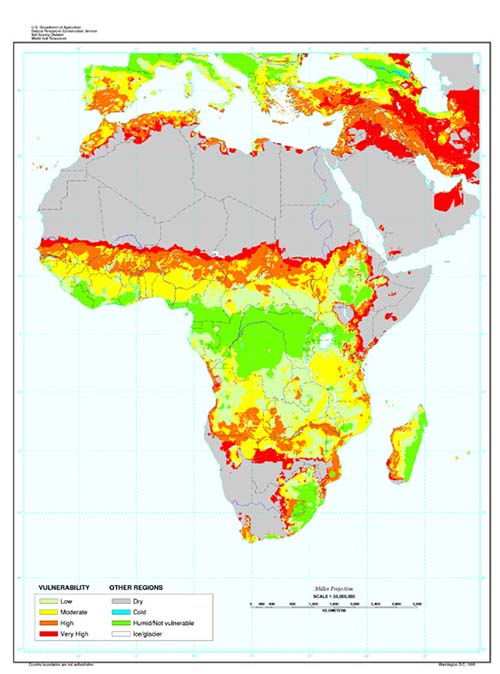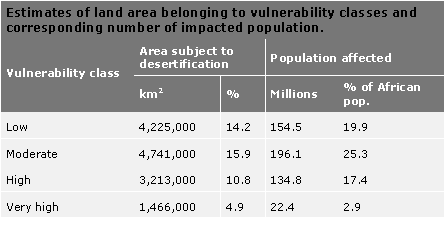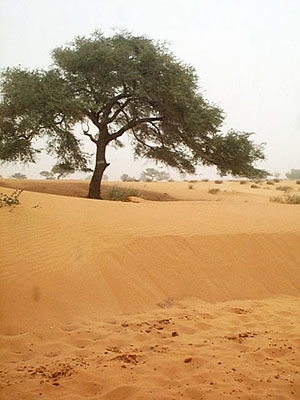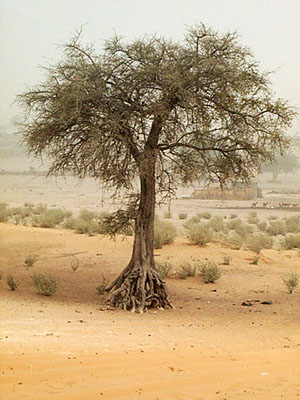The desertification is the degradation of land in arid and dry sub-humid areas, resulting from anthropic and natural activities and influenced by climatic variations. We now know anthropic activities are the major cause of the desertification. Indeed this phenomenon is mainly induced by several factors like overgrazing, over-cultivation, increased fire frequency, water impoundment, deforestation, overdrafting of groundwater, increased soil salinity, and global climate change. The major impact of desertification is biodiversity loss and loss of productive capacity.
Former United Nations (UN) Secretary-General, Kofi Annan, has said that desertification undermines the fertility of the world’s land, with productivity losses reaching 50% in some areas. Today, a third of the Earth’s surface is threatened by desertification, which adds up to an area of over 4,000 million hectares (ha) of the planet.
Even though it is a global problem, its impact is more devastating in Africa, where an important part of the population lives in the rural areas whose major occupations are farming and animal rearing. The land for these occupations are being lost every day through desertification and other forms of land degradation.

Desertification vulnerability of Africa. Source: Land Resource Stresses and Desertification in Africa
 As we can see on the figure above, 42% of the African territory is covered by dry land defined as unsuitable for any kind of sustainable agriculture. The regions closed to these dry lands have a very high degree of vulnerability regarding the desertification. Indeed, desertification threatens another 15% of the continent where 20% of the African population live (see figure on the right).
As we can see on the figure above, 42% of the African territory is covered by dry land defined as unsuitable for any kind of sustainable agriculture. The regions closed to these dry lands have a very high degree of vulnerability regarding the desertification. Indeed, desertification threatens another 15% of the continent where 20% of the African population live (see figure on the right).
It has been demonstrated that low-input agriculture, particularly in the absence of appropriate conservation practices, leads to degradation of the land. As African farming is essentially a low-input low-output system, land degradation is rampant and recent studies show a progressive decrease in the performance of the land.
The situation is further constrained by the geometric increase in animal population. When populations were low, shifting cultivation and transhumance pastorals were appropriate to circumvent declining productivity. Due to land availability and national regulations, these are no longer options.
Per capita land has now declined from about 0.5 ha/person to less than 0.3 ha/person (Barnes, 1990).
In the other hand, forest consumption in Africa is estimated at about 3 million ha per year. Where the vegetation disappears the soil becomes exposed to wind, causing soil particles to be deposited elsewhere. The top layer becomes eroded. With the removal of shade, rates of evaporation increase and salts become drawn up to the surface. This increases soil salinity which inhibits plant growth. The loss of plants causes less moisture to be retained in the area, which may change the climate pattern leading to lower rainfall.
The desertification not only contributes to food insecurity, famine and poverty, but may also fuel social, economic and political tensions (people displaced by desertification put new strains on natural resources and on other societies nearby) that can cause migration, conflicts, further poverty and land degradation.

Tree buried by walking dune, Niger. Source: M. Salmon, 2003

Roots exposed by wind erosion, Niger. Source: M. Salmon, 2003
Combating desertification is complex and difficult, usually impossible without alteration of land management practises that led to the desertification. Over-exploitation of the land and climate variations can have identical impacts and be connected in feedbacks, which makes it very difficult to choose the right mitigation strategy. A number of methods have been tried in order to reduce the rate of desertification and regain lost land; however, most measures treat symptoms of sand movement and do not address the root causes of land modification such as overgrazing, unsustainable farming (e.g. cattle farming) and deforestation. In this context, it is also important to note that formulation of international and global policies for combating this phenomenon have been hindered by a lack of concrete data about the rates and extent of desertification.
Sources
Desertification, a challenge for Africe - World press
Land degradation and desertification in Africa - The encyclopedia of Earth
Land Resource Stresses and Desertification in Africa - US Natural Resources Conservation Service
Overcoming One of the Greatest Environmental Challenges of Our Times: Re-thinking Policies to Cope with Desertification
Population growth, wood fuels, and resource problems in sub-Saharan Africa. Industry and Energy Dept. Working Paper No. 26. Washington, D.C.: World Bank
The encyclopedia of earth
Wikipedia - Desertification
Links
EOEdu Applications: desertification
United Nations Convention to combat Desertification
This page was written in 2009, as additional information to the poster series "10 years of Imaging the Earth"